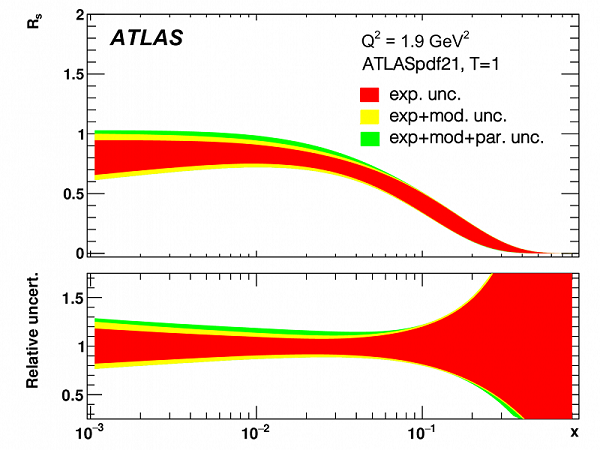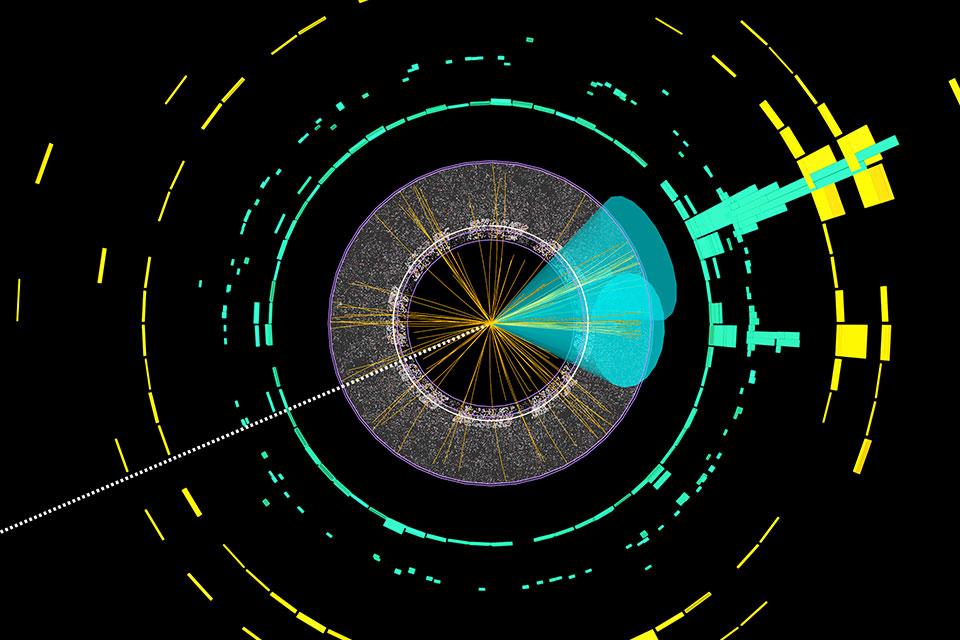The ATLAS collaboration, of which Oxford is a founding member, has shed new light on the behaviour of partons – the quarks and gluons inside protons.
When protons are smashed together in the Large Hadron Collider (LHC), understanding how partons behave within the proton is key to predicting different phenomena – including the potential discovery of a new particle. Parton distribution functions (PDFs) describe what fraction of a proton’s momentum is taken by its constituent quarks and gluons and traditionally, knowledge of these PDFs has come from lepton-proton colliders such as HERA at DESY. The latest paper released by the ATLAS collaboration combined LHC and HERA data for a fresh perspective on PDFs.
A detailed look into PDFs
Research to date revealed that, in addition to the well-known up and down valence quarks that are inside a proton, there is also a sea of quark–antiquark pairs in the proton. This sea is theoretically made of all types of quarks, bound together by gluons. Now, studies of the LHC’s proton–proton collisions are providing a detailed look into PDFs, in particular the proton’s gluon and quark-type composition.
The latest paper uses ATLAS data from several different Standard Model processes, including the production of W and Z bosons, pairs of top quarks and hadronic jets (collimated sprays of particles). It was traditionally thought that the strange-quark PDF would be suppressed by a factor of ~2 compared to that of the lighter up- and down-type quarks, because of its larger mass. The new paper confirms a previous ATLAS result, which found that the strange quark is not substantially suppressed at small proton momentum fractions and extends this result to show how suppression kicks in at higher momentum fractions (x > 0.05) as shown in figure 1.

Several experiments and theoretical groups around the world are working to understand PDFs. While their results are generally in agreement, there has been some variance at the high-momentum fraction (x > 0.1) that could impact high-energy searches for physics beyond the Standard Model. Further, it has become increasingly clear that a better understanding of PDFs at mid-range momentum fractions (x ~ 0.01–0.1) is needed if physicists are to find evidence for new-physics processes in the deviations from the Standard Model of quantities such as the mass of the W boson or the weak mixing angle. This would require knowledge of PDFs to an accuracy of ~1%.
ATLAS: a powerful contribution
This is where the ATLAS analysis contributes most powerfully, as the accuracy of the PDFs depends on detailed knowledge of the systematic uncertainties of the input data. The ATLAS Collaboration is able to assess the correlations of such uncertainties between their datasets and account for them – an ability put to great effect in their new PDF result. Such knowledge was not previously available outside ATLAS, making this result a new “vademecum” for global PDF groups. It turns out that the impact of such correlations can shift the central values of the PDFs by > 1% in the mid-range momentum region, and by much more than this in the high-x region.
‘These latest results on parton distribution functions show that ATLAS data can now provide complete information on both quark flavour structure and the gluon – with the crucial advantage that experimental correlations are well understood,’ comments Professor Amanda Cooper-Sarkar who, along with Professor Claire Gwenlan, also from Oxford, led the analysis. ‘This not only impacts the accuracy of this analysis but also of many future analyses which will use these data.’
Searching for new physics processes
ATLAS’ new understanding of PDFs will be used in the search for new physics processes when the LHC restarts later this year. Further, the techniques described in the paper will aid future analysis groups – both at ATLAS and beyond – in determining more accurate parton distribution functions.
ATLAS is one of the four major experiments at the Large Hadron Collider (LHC) at CERN; it is a general-purpose particle physics experiment run by an international collaboration designed to exploit the full discovery potential and the huge range of physics opportunities that the LHC provides. Oxford is a founding member of the ATLAS collaboration. We play a major role in testing the predictions of the Standard Model, Higgs boson studies, searches for new particles and interactions beyond the Standard Model. We are also making major contributions to the upgrade of the ATLAS detector for the High-Luminosity LHC.

